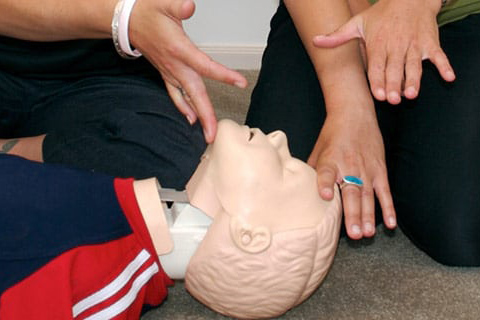Learning first aid skills is vital for everyone. In any life-threatening emergency within the workplace, employees must act promptly and treat any potential medical issues. The quicker someone administers first aid, the greater chance they have of saving someone’s life.
Businesses should be ensuring that their workers are properly trained in first aid by implementing First Aid Training courses and strategically placing First Aid Kits around the workplace. With these resources, everyone will be aware of the crucial first aid skills needed in case of unexpected emergencies. We’ve outlined the main points below!
1. Perform CPR & Defibrillation
CPR is an absolute must for first aid training. Performing CPR will provide you with the skills and knowledge to maintain breathing and circulation in a person following a cardiac arrest.
Check out the Red Cross’s step-by-step guide to performing CPR on adults.
Alternatively, an Automated External Defibrillator (AED), can be used to handle cardiac emergencies in the workplace and beyond. It is a portable electronic device that automatically sends an electric pulse or shock to restore a heartbeat. It is highly recommended by WHS legislation.
2. Heimlich Manoeuvre
The Heimlich Manoeuvre is used to help someone who is choking. In any emergency situation, choking can be identified if the individual cannot talk. You only have a 5 minute window to dislodge the foreign object before brain damage occurs.
To perform this first aid skill, you should stand behind the victim and wrap your arms behind them. Then, you place a fist between the person’s rib cage and belly button, before placing your other hand over that fist. Do several quick thrust upwards until the foreign object is dislodged.
The Heimlich Manoeuvre for children requires a different approach due to their smaller bodies.
3. Treat Burns
There are several types of burns, which all need to be treated differently:
- First Degree Burns only affect the top layer of the skin, causing painful tenderness and mild swelling. These can be treated by running cool water over the skin or taking an aspirin. Antibiotic ointment can also be applied, along with loose gauze wrapping.
- Second Degree Burns can be identified by blisters and thickening of the skin. The affected area should be run under cool clean water for 15 minutes. Placing ice on top is not recommended since it can tear off delicate skin. Antibiotic ointment and gauze can be used.
- Third Degree Burns are the most life-threatening burns. They take on a white, leathery appearance and due to their deepness, they are very difficult to treat and can require amputations.
4. Treat Hypothermia
Hypothermia occurs when your body loses heat faster than it can generate it, leading to an abnormally low body temperature. Extreme coldness can cause confusion, fatigue, slurred speech, a weak pulse, and even loss of consciousness.
It is important to ensure that the victim is warmed up slowly and gradually to the right temperature. Heating or massaging the limbs of the affected person can also create stress on the heart and lungs.
Treating hypothermia involves gently removing and insulating the victim from the cold. This could mean removing wet clothing and replacing these with warm blankets or coats. Offering warm (non-alcoholic) drinks is also an option, alongside towel-wrapped hot water bottles and packs.
5. Stop Heavy Bleeding
When a main artery/vein is severed and the blood clot cannot be formed, the victim can bleed out within 10-15 minutes. This can be treated by putting pressure on the wound with a sterile cloth. Raising the wounded limb over the heart can also minimise heavy bleeding.
Identifying signs of arterial bleeding is especially important because the victim could potentially bleed out and die in just minutes. Arterial wounds are usually pulsating and have bright red blood. You must immediately put pressure on the wound until paramedics arrive and add any extra cloth if required.
6. Treat a Concussion
Concussions are defined as a mild traumatic injury caused by impact, resulting in a temporary loss of normal brain function. They are often silent assassins, so as part of first aid training, it is important to recognise the various symptoms such as headaches, concentration and memory problems, delayed speech, loss of balance and coordination.
For more information about how to diagnose and treat concussions, click here.
7. Soothe a Sprain
Many work environments can cause injuries and accidents for employees, along with any strenuous physical activity. As such, sprains can become quite common, so it is essential to know how to treat them, whether they involve rolled ankles, bruised knees or twisted shoulders.
An ace bandage can help soothe the pain of a sprained joint. After resting, the victim should make sure to avoid any physical exertion to prevent long-term cartilage and tissue damage.
8. Revive Drowning
After a near-drowning incident, first aid training becomes crucial.
You must ensure that the victim has an open airway by thrusting the jaw open, enabling the person to breathe. Pinch the nose of the victim closed and then place your mouth over theirs, creating an airtight seal. Give 2 breaths followed by 30 chest compressions – keep repeating this process until medical help arrives.
So that wraps it up – the essential first aid skills that everyone should know. To spread awareness of these crucial life-saving information and safety tips, share this article with people around you!
For comprehensive first aid equipment and resources, visit Alsco First Aid Training. It’s affordable, flexible and compliant with WHS regulations – perfect for your business’s safety.

